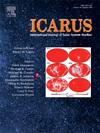The blinking crystallinity of Europa: A competition between irradiation and thermal alteration
IF 2.5
2区 物理与天体物理
Q2 ASTRONOMY & ASTROPHYSICS
引用次数: 0
Abstract
The surface of Europa experiences a competition between thermally-induced crystallization and radiation-induced amorphization processes, leading to changes of its crystalline structure. The non-linear crystallization and temperature-dependent amorphization rates, incorporating ions, electrons and UV doses, are integrated into our multiphysics surface model (MSM) LunaIcy, enabling simulations of these coupled processes on icy moons.
Thirty simulations spanning , covering the full ranges of albedo and latitude values on Europa, explore the competition between crystallization and irradiation. This is the first modeling of depth-dependent crystallinity profiles on icy moons. The results of our simulations are coherent with existing spectroscopic studies of Europa, both methods showing a primarily amorphous phase at the surface, followed by a crystalline phase after the first millimeter depth. Our method provides quantitative insights into how various parameters found on Europa can influence the subsurface crystallinity profiles.
Interpolating upon our simulations, we have generated crystallinity maps of Europa showing highly crystalline ice near the equator, amorphous ice at the poles, and a mix of the two at mid-latitudes. Regions/depths with balanced competition between crystallization and amorphization rates are of high interest due to their periodic fluctuations in crystalline fraction. Our interpolated map reveals periodic variations, with seasonal amplitudes reaching up to 35% of crystalline fraction. These variations could be detected through spectroscopy, and we propose a plan to observe them in forthcoming missions.
闪烁的木卫二结晶:辐射与热蚀变的竞争
木卫二表面经历了热致结晶和辐射致非晶化过程的竞争,导致其晶体结构发生了变化。非线性结晶和温度依赖的非晶化速率,包括离子、电子和紫外线剂量,被集成到我们的多物理场表面模型(MSM) LunaIcy中,使这些耦合过程能够在冰冷的卫星上模拟。30个跨越10万年的模拟,覆盖了欧罗巴反照率和纬度值的全部范围,探讨了结晶和辐射之间的竞争。这是第一次对冰冻卫星上与深度相关的结晶度进行建模。我们的模拟结果与现有的木卫二光谱研究一致,两种方法都显示表面主要是无定形相,然后在第一毫米深度之后是结晶相。我们的方法为在木卫二上发现的各种参数如何影响地下结晶度剖面提供了定量的见解。在模拟的基础上,我们绘制了木卫二的结晶图,显示赤道附近有高度结晶的冰,两极有非晶态冰,中纬度地区则是两者的混合。由于结晶率的周期性波动,在结晶率和非晶化率之间具有平衡竞争的区域/深度受到高度关注。我们的插值图显示了周期性的变化,季节性的振幅达到35%的晶体分数。这些变化可以通过光谱学检测到,我们提出了一个计划,在即将到来的任务中观察它们。
本文章由计算机程序翻译,如有差异,请以英文原文为准。
求助全文
约1分钟内获得全文
求助全文
来源期刊

Icarus
地学天文-天文与天体物理
CiteScore
6.30
自引率
18.80%
发文量
356
审稿时长
2-4 weeks
期刊介绍:
Icarus is devoted to the publication of original contributions in the field of Solar System studies. Manuscripts reporting the results of new research - observational, experimental, or theoretical - concerning the astronomy, geology, meteorology, physics, chemistry, biology, and other scientific aspects of our Solar System or extrasolar systems are welcome. The journal generally does not publish papers devoted exclusively to the Sun, the Earth, celestial mechanics, meteoritics, or astrophysics. Icarus does not publish papers that provide "improved" versions of Bode''s law, or other numerical relations, without a sound physical basis. Icarus does not publish meeting announcements or general notices. Reviews, historical papers, and manuscripts describing spacecraft instrumentation may be considered, but only with prior approval of the editor. An entire issue of the journal is occasionally devoted to a single subject, usually arising from a conference on the same topic. The language of publication is English. American or British usage is accepted, but not a mixture of these.
 求助内容:
求助内容: 应助结果提醒方式:
应助结果提醒方式:


